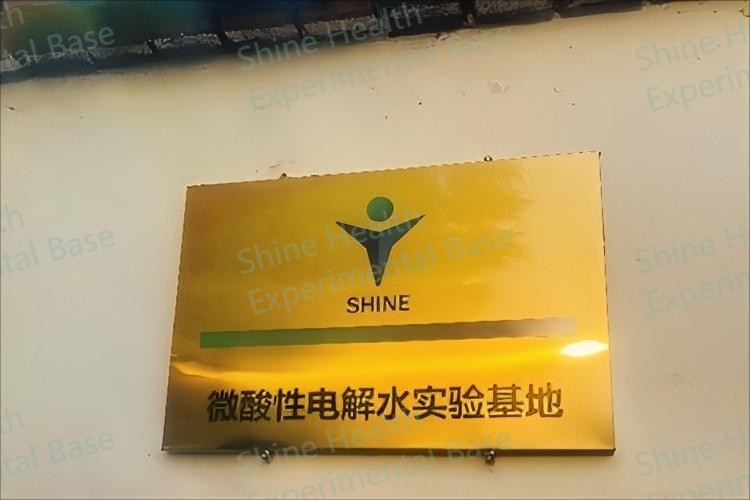What is another name for hypochlorous acid?
At Shandong Shine Health Co., Ltd., we're always seeking more secure, extra efficient remedies. One of our discoveries is slightly acidic electrolytic water, frequently a game-changer in numerous industries. You may be wondering-- what's another name for hypochlorous acid? Well, hypochlorous acid (HOCl) is likewise referred to as slightly acidic electrolytic water or slightly acidic REDOX potential water. These terms describe the very same powerful compound, but they highlight different facets of its production and application.

Allow's study this flexible liquid, discover its benefits, and why it's promptly ending up being a best solution for sanitization and sanitation across numerous industries.
What is Slightly Acidic Electrolytic Water?
Slightly acidic electrolytic water, additionally called slightly acidic REDOX potential water, is produced by electrolyzing a diluted hydrochloric acid remedy (2-6%). The result is an extremely reliable disinfecting liquid with a pH between 5.0-6.5 and an efficient chlorine focus of 10-500 ppm. It's anemic, odor-free, and secure to make use of, making it an excellent option for applications ranging from food safety and security to environmental hygiene.

Just How Does Slightly Acidic Electrolytic Water Work?
The magic behind slightly acidic electrolytic water depends on the generation of hypochlorous acid during electrolysis. This highly efficient disinfectant particle is incredibly fast-acting, with sanitizing power approximately 80 times greater than its ionized equivalent, hypochlorite. This makes it an incredibly effective selection for cleansing and sterilizing.
Why Choose Slightly Acidic Electrolytic Water?
When contrasted to typical sanitizers like sodium hypochlorite or alcohol-based remedies, slightly acidic electrolytic water uses a number of advantages. First, it's safe, making it much safer for both the environment and individuals utilizing it. Second, its manufacturing doesn't launch chlorine gas, which is a well-known environmental threat. Ultimately, it has reduced residuals, implying there's no demand for second cleaning or neutralization.
Advantages in Food Industry Disinfection
In the food market, health and safety and security are extremely important. Slightly acidic electrolytic water can replace harsher chemicals typically utilized for food disinfection. It's not only risk-free for direct contact with food, however it likewise provides effective sanitization without changing the food's taste, structure, or appearance. Whether for vegetables, meat, or food handling devices, this innovation supplies a green and cost-efficient alternative to the status quo.

Ecological Benefits: A Cleaner, Greener Future
Among the vital advantages of slightly acidic electrolytic water is its low ecological effect. Unlike bleach-based anti-bacterials, which can leave damaging deposits and add to water pollution, slightly acidic electrolytic water breaks down into safe materials. It's totally compliant with wastewater discharge guidelines, suggesting it can be securely released after usage without further treatment.
Non-Damaging to Surfaces
Numerous usual sanitizers can create damages to delicate surface areas or products. However, slightly acidic electrolytic water is pH-balanced (in between 5.5 and 6.5), ensuring it won't damage surfaces or leave behind hazardous deposits. This makes it excellent for usage in numerous settings, including healthcare, food manufacturing, and friendliness.
Speed of Action: 80 Times More Effective
Hypochlorous acid molecules in slightly acidic electrolytic water are far more powerful than their ionized equivalents. Their capability to eliminate bacteria, viruses, and other pathogens depends on 80 times faster, making this service ideal for fast disinfection without endangering performance.

Why Hypochlorous Acid is So Effective
Hypochlorous acid particles are naturally produced by the human body immune system to fight off infection. This makes them not just highly effective at disinfecting yet likewise reasonably non-toxic to human beings, animals, and plants. The body uses them in a similar method when combating bacteria and viruses, which clarifies their widespread use in sanitation.
Safe for Hand Contact: No Skin Damage
Unlike more powerful acids or extreme chemicals, slightly acidic electrolytic water is safe for contact with human skin. With a pH of 5.5-6.5, it will not trigger irritability or dryness, making it appropriate for usage in environments where constant hand sanitization is essential.
Applications in Healthcare
In medical care setups, sanitation is crucial, and decontaminating high-touch surfaces is an everyday need. Slightly acidic electrolytic water can be used in health centers, facilities, and assisted living facility to sterilize surface areas, tools, and also clinical devices, decreasing the danger of cross-contamination and infection.
Decreasing Costs and Environmental Impact
Using slightly acidic electrolytic water lowers the reliance on expensive, non reusable sanitizing agents. And also, since it's non-toxic and secure for disposal, it decreases the environmental worry of unsafe chemicals.
How to Use Slightly Acidic Electrolytic Water
To utilize slightly acidic electrolytic water, simply apply it to surfaces using a sprayer or cleaning towel. It's reliable in both commercial and household settings, from cleansing kitchen areas to decontaminating hospital rooms.

Safety And Security Standards and Regulations
Slightly acidic electrolytic water has actually been accepted for use in various nations due to its safety and security and efficiency. Japan's Ministry of Health, Labour, and Welfare carried out studies and confirmed that this type of water satisfies safety criteria for usage in food-related settings. It's secure, sustainable, and fulfills international governing requirements.
How to Make Slightly Acidic Electrolytic Water
Making slightly acidic electrolytic water needs an electrolyzer that can securely and efficiently split a thin down hydrochloric acid solution into hypochlorous acid. This procedure is simple to set up and doesn't need difficult equipment or handling of unsafe materials. As soon as developed, it's prepared for usage in a selection of cleaning and sanitizing jobs.
Where to Buy Slightly Acidic Electrolytic Water Machines?
If you're aiming to purchase an equipment that creates slightly acidic electrolytic water, we at Shandong Shine Health Co., Ltd. supply advanced modern technology to meet your needs. Our Shine HOCl generator is an efficient, cost-effective service for generating hypochlorous acid onsite for all your sanitation requires.
The Future of Sanitization
As industries relocate towards even more sustainable, non-toxic sanitizing remedies, slightly acidic electrolytic water is poised to take center stage. With its powerful disinfecting properties, security for both people and the setting, and cost-efficiency, it's clear that this modern technology is right here to stay.
Conclusion: Why You Should Consider Slightly Acidic Electrolytic Water
Finally, slightly acidic electrolytic water is not simply another name for hypochlorous acid-- it's a sophisticated option for sanitation, cleaning, and sanitization that's both effective and environmentally friendly. Whether in food production, medical care, or other markets, it uses a series of benefits that can help reduce expenses, boost safety and security, and reduce ecological influence.
At Shandong Shine Health Co., Ltd., we're excited to bring this innovation to the center, aiding industries take on much better, cleaner, and more lasting methods.
References:
"Safety and Effectiveness of Slightly Acidic Electrolytic Water in Food Disinfection." Ministry of Health, Labour, and Welfare, Japan.
"Electrolyzed Water: A Safer and Greener Disinfectant." Environmental Health Perspectives.
"Electrolytic Water Technology and Its Applications." Journal of Environmental Science and Technology.
"Slightly Acidic Electrolytic Water and Its Applications in Healthcare." International Journal of Infection Control.
"Hypochlorous Acid: An Effective Disinfectant with a Safe Profile." PubMed.
